13 Amazing Rowing Machine Health Benefits
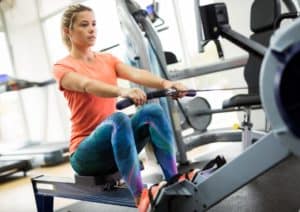
And trust me, there are A LOT!
In my opinion, rowing machines are the best cardio machines in your gym (or home gym). Ask any fitness expert and they’ll agree!
After all, no other machine works your entire body as efficiently or gives you such versatility in your training intensity as the rowing machine.
Walk into any CrossFit box or weightlifting gym, and you’ll find the rowing machine is virtually always occupied. That’s because smart trainees know just how amazing it is as a “clean-up” workout after an intense weight training session.
I previously wrote a post on Rowing Machine Benefits, but I wanted to take this opportunity to expand the information and give you a more complete list!
13 Amazing Health Benefits of a Rowing Machine
I’m going to take the time to walk you through the MANY health benefits of using a rowing machine.
Hopefully, it will help you understand why this one simple piece of equipment is the ultimate training tool at every fitness level.
1. Full-Body Workout
Look at every other cardio machine in the gym and none of them can give you a full-body workout like a rowing machine. The only one that comes close is the elliptical. Every other machine, from the treadmill to the exercise bike, focuses exclusively on your upper body.
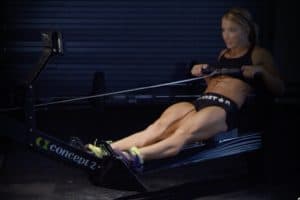
With the rowing machine, your lower body does 65-75% of the work. Chiefly in the drive part of the stroke, when you push back with your legs. The primary lower-body muscles targeted are:
- Quads (front of thigh muscles)
- Calves
- Glutes (butt)
- Hamstrings (back of thigh muscles)
However, your upper body still does about 25-35% of the work throughout the entire stroke. Rowing targets the majority of the upper body muscles, including:
- Chest
- Upper Back
- Lower back (spinal supporters)
- Abs
- Shoulders (particularly the posterior deltoids)
- Biceps
- Obliques (sides)
That’s more muscles engaged in a single exercise than any other type of workout, PERIOD! Even advanced training movements like burpees or walking shoulders presses don’t activate as many muscles as rowing machines.
2. Low-Impact
High-impact exercises—like plyometric training, sprint training, and running—can increase your risk of joint strain or worsen existing joint, muscle, or spinal problems.
Rowing, on the other hand, involves no impact at all. You’re sitting down and simply extending and bending your legs with ZERO impact. So there is far less strain on your joints! It’s perfectly safe for people prone to knee, ankle, hip, back, shoulder, elbow, and neck injuries.

This means that people who are limited by the type of exercises they can perform (from joint pain) can now work out and receive all the health benefits like losing weight, a healthier cardiovascular system, lower blood pressure, etc.
3. High-Calorie Burn
I’ve written a couple of comparison articles—Rowing Machine vs. Bike and Rowing Machine vs. Elliptical—that look at how many calories you can burn rowing versus working out on other cardio machines.
What I discovered through the research and writing process is that rowing machines have the potential to burn more calories than any other cardio machine (except, perhaps, sprint training on a treadmill).
Just check out my chart in this post on how many calories a rowing machine burns.
Pretty amazing, right? As a bigger guy myself, it’s great to see that I can burn close to 400 calories in just one vigorous 30-minute rowing session!
We all know that burning more calories means losing more weight, which translates to a laundry list of health benefits!
4. Cardiovascular Conditioning & Muscular Endurance
Rowing is unique in that it’s one of the few forms of exercise that targets both your cardiovascular and muscular conditioning.
Resistance training (weightlifting) focuses chiefly on your muscles, but it can lead to some minor cardiovascular improvements. Cardio machines (like the treadmill) focus chiefly on cardiovascular conditioning, with some muscular growth.
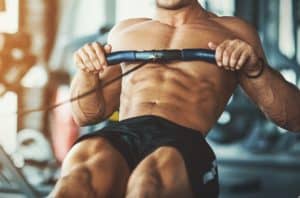
But rowing combines both forms of exercise into one. The total-body workout pushes your heart and lungs to work more efficiently and it builds endurance in the muscles that are engaged through the rowing stroke.
As a result, you’ll see faster improvement in your overall fitness because of your (excellent) choice of workout!
5. Ideal Post-Workout Training
For those who want to burn extra fat in their workouts, the best way to do that is to do 10-20 minutes of low-intensity cardio after a resistance training session.
Why is that?
To put it simply: your body has two forms of energy available:
- Glucose (blood sugar)
- Lipids (fats)
Glucose is easiest to burn because it’s already present in your bloodstream and easily accessible from your liver. There’s around 400-500 calories worth of glucose ready for your body to burn.
But, as your exercise burns through those calories, your body has to supplement the depleting energy by tapping into the harder-to-activate energy stored in fat cells. In fact, your body doesn’t start burning fat until it’s already consumed a lot of the glucose, and only then as a “backup” energy source until you’ve mostly burned through the available glucose.
Resistance training and HIIT training—called “anaerobic exercise”—uses glucose to keep your muscles fueled. However, in order to burn fat, you have to do lower-intensity “aerobic exercise”, including jogging, walking, and, of course, rowing.
The problem is, if you started off the workout with your walk, run, or rowing session, your body would simply burn through the glucose first, and there would be very little left in your tank when it comes time to lift weights.
But doing the resistance training first ensures that all of the glucose is consumed, and finishing off with a post-training cardio session (on the rowing machine, of course!) burns as much fat as possible.
Rowing makes for perfect post-workout cardio because it’s low-impact, won’t push your already-exhausted muscles beyond their “safe” limits of exertion, and provides you with a highly effective fat-burning exercise.
6. Excellent Rehab
As I mentioned above, rowing is a low-impact cardio workout that places no unnecessary strain on your joints. This makes it one of the best forms of physical therapy and rehabilitation exercise for almost every part of your body.
Rowing puts you in full control of your speed, resistance, and posture. If you experience even the slightest bit of pain from a healing injury, you can slow down, lower the resistance, or shift your position just enough to minimize the pain.
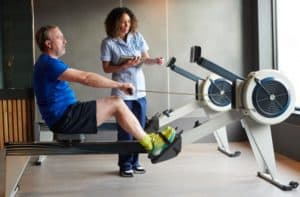
Studies have shown that rowing machines make great workout tools for pretty much any injury: spinal injuries, shoulder pain, knee injuries, and more.
So as you get older and experience more joint injuries, a rowing machine will allow you to continue receiving all the health benefits of a low-impact cardio workout!
7. Improves Posture & Mobility
One of the best rowing machine health benefits I’ve noticed over the years is improved posture and mobility.
When I started rowing, I just sat down and started pulling on the handle. Without paying much attention to my rowing form, it quickly led to some injuries and aches.
During my recovery, I took time to really focus on improving my rowing form. I learned everything I could—from the four stages of the rowing stroke to the right way to grip the handle to the proper foot position, even the best shoes to wear for rowing!
I took everything I’d learned and put it into practice. To no surprise, my pain went away and my injuries healed.
All of that attention to my form paid off in every aspect of my movement and exercise. By increasing my awareness of the way I was sitting and rowing, I began to become aware of how I moved through other activities. I began to sit up straighter, improve my spinal alignment, and squat down better.
Thanks to this increased body awareness, I have a better posture overall and have begun noticing increased mobility in my hips, knees, ankles, spine, shoulders, and elbows.
8. Repetitive & Meditative
This is one of my personal favorite health benefits of using a rowing machine!
Most steady-state cardio workouts are incredibly repetitive. Whether running, cycling, or rowing, you repeat the exact same motion over and over for the duration of the workout. This certainly has the potential to get boring, but I’ve noticed that once I settle into a groove, I can almost tune out the exercise and just let my mind drift along.
Research has shown that exercises like rowing tend to have a self-hypnotic effect. They can almost put you into a meditative trance because your brain adapts to the repeated movement so thoroughly that it no longer needs to think about what it’s doing.
When this happens, your mind can wander away from your workout and you sort of lose yourself in the movement. At the end of the training session, you walk away surprisingly more relaxed than you’d expect!
And let’s not forget all of the endorphins you release from exercising!
There are some cool, free Youtube videos that can help get you into that meditative state:
9. Increase Grip Strength
Your lower body does a lot of the work propelling you backward during the “Drive” portion of the rowing stroke. However, during the “Finish” when you haul on the handle, it’s your upper back, shoulders, and arms that are engaged—particularly your forearms.
You see, your grip strength doesn’t actually come from your hands. No, it’s your forearm muscles that flex and extend your fingers.
(Don’t believe me? Turn your hand palm-side up, and bend your fingers one at a time. You’ll see all of the various muscles in your forearms contracting and relaxing to move your hands.)
Good grip strength is needed for just about everything: from doing pull-ups to gripping heavy weights to bringing in the shopping to fixing your car. Unfortunately, a lot of people focus more on the “glamor muscles” in the arms—the biceps, triceps, and shoulders—but neglect to train their forearms. This is one of the primary factors behind so many wrist injuries.
Training your grip strength is absolutely critical for greater overall arm strength. It’s always worth including exercises that strengthen your forearms—including, of course, rowing.
10. Targets Glutes, Hips, and Core
What makes rowing an excellent workout (compared to cycling or running)? Well, it focuses on some very critical muscles:
- Core (abs, lower back)
- Hips
- Glutes (butt muscles)
These muscles play a critical role in healthy movement, posture, and balance. Since they connect your lower and upper body, they’re activated every time you move.
It should come as no surprise to learn these are also the most common “trouble spots” for injuries or strains. Lower back injuries are among the most common injuries IN THE WORLD. It’s estimated that:
- Roughly 2 million back injuries occur every year in the U.S.
- 80% of adults will suffer back injuries at some point in their lives
- Back injuries are the single highest cause of “job-related disability”
Your lower back is critical for every twisting, turning, bending, standing, and sitting movement. Your abs also work with the lower back muscles to support your spine.
Because we spend so much time sitting every day, our lower back muscles can actually weaken from reduced use. The weakening is even more prominent in the glutes and hips. These muscles are almost completely sedentary for the long hours you spend sitting down, so they become less effective at facilitating full-body movement.
When your hips and glutes get weaker, your body tries to compensate by engaging the abs and lower back muscles more. This can drastically increase the risk of lower back injuries because one set of muscles is doing the work of multiple muscle groups.
I’m not exaggerating when I say that training your hips, glutes, and core is JUST as important as training every other muscle in your body. You’ll move better, have greater strength for every activity and movement, and lower your risk of injuries.
11. Cross-Training
Rowing is utilized by CrossFitters and advanced athletes around the world because it is a full-body workout that works for virtually every sport and exercise on the planet.
Runners and triathletes even train on rowing machines because it’s a low-impact and highly-adaptable form of exercise. Heck, even Conor McGregor’s coaches wanted him to use a rowing machine to improve his performance!
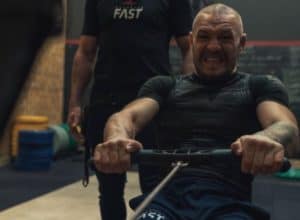
You can train your absolute hardest on the rowing machine, but you won’t feel it in your joints or muscles the next day. It also develops a dynamic range of motion that will increase functional strength and flexibility—something every athlete and fitness trainee can benefit from.
12. Accessible for All
One thing that got me hooked on rowing immediately (all those many years ago) was the fact that I could push myself as hard as I possibly could—and keep pushing myself harder and harder as my fitness developed.
I wasn’t the fittest guy right out of the gate, but rowing challenged me enough that I started to actually look forward to my daily workouts. Sure, I was a total newbie to working out, but I could row my heart out every time I sat down.
As I got stronger and my endurance increased, all I had to do to make the workout harder was to row faster or increase the difficulty level.
But rowing machines are designed specifically for trainees of all levels. Whether you’re new to training or an elite athlete, all you have to do is raise/lower the difficulty setting or row faster/slower, and you’ve got the perfect workout for your specific fitness.
13. Highly Adaptable
Let’s be honest: we don’t all train to THE MAX every single day.
Sure, there are plenty of days when you really want to push yourself and take your fitness to the next level! However, sometimes, I just want to do a light cardio session that will work up a sweat without going “balls to the wall”.
That’s another thing I love about rowing machines and one of the best health benefits of using a rowing machine. Because you can adjust your rowing speed and difficulty level, you can adapt the machine to match your workout of the day.
To go all out, set the difficulty to the top and row your heart out. To enjoy a light workout, turn down the difficulty and row a bit slower.
It’s fully adaptable according to your workout so you will row more often!
Overall Review
Pretty amazing, isn’t it? Rowing isn’t just one of the most enjoyable forms of exercise—it’s also one of the most effective!
It’ll give you a full-body workout without straining your joints or pushing your tired muscles to risky extremes. Plus, it lets you choose the intensity of your training session based on how you feel!
Not only will it improve your cardiovascular and muscular endurance while burning A LOT of calories, but it strengthens your core muscles and helps to improve posture, balance, and joint mobility.
Now that’s the kind of workout you can learn to love!
I hope this list of the rowing machine health benefits gives you the push you need to give rowing a try. Next time you’re at the gym, hop on the rowing machine and aim for a 20 to 30-minute rowing session. I guarantee you’ll walk away feeling like a million bucks.
If you’re considering buying a rowing machine, check out my top-rated rowers here.
You can also browse the different models on my rowing machine comparison page.
Rowing changed my life, and I can’t imagine enjoying any other workout as much as my daily rowing sessions. Once you try it, I’m certain you’ll feel the same, too!

Rowing Machine King Founder and Author.
